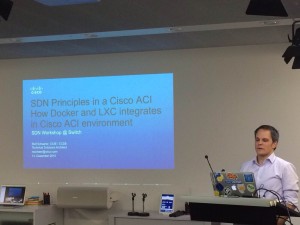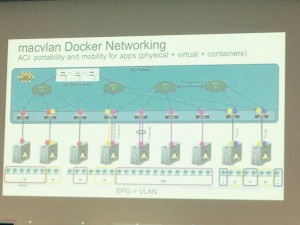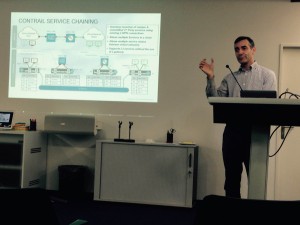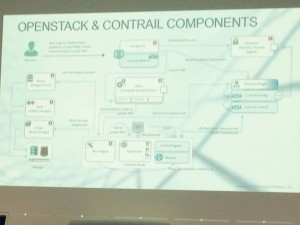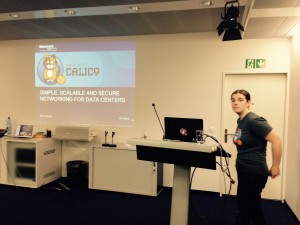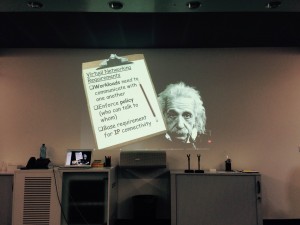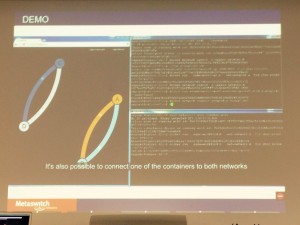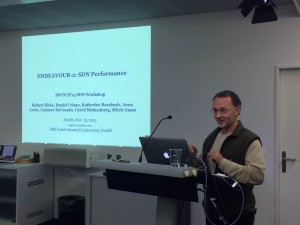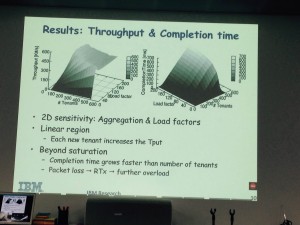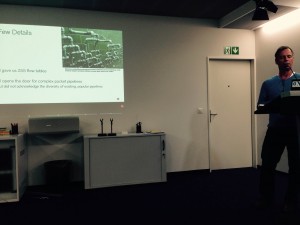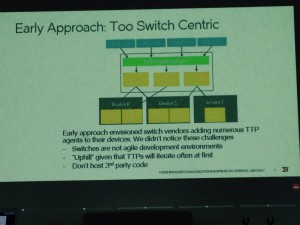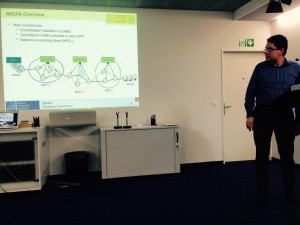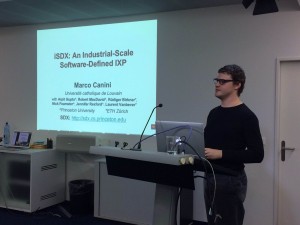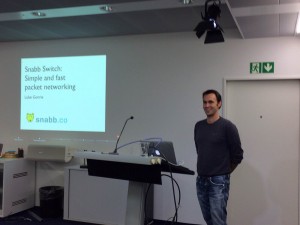Last Friday, 13th November the 5th SDN workshop took place at the SWITCH premises in Zurich. With 9 presentations covering different aspects of Software Defined Networking and around 40 attendees, we are happy to bring together the academia and industry partners on the same table in order to provide to the community a complete overview of the most recent results, products and open source SDN solutions.
Compared with the previous workshops, talks from the industry were prevalent this time, which brought variety but most importantly an intent to close the gap between SDN research projects and grand-scale solutions based on customer use cases.
Rolf Schärer from Cisco presented their novel application-centric infrastructure (ACI) created upon the SDN principles and its integration inside Docker (LXC) to act as a centralized network policy management for containers. ACI supports Docker’s veth and macvlan using the OpFlex and OVS in order to enforce policy between containers. The ACI enables segmentation and isolation based on VXLAN abstracted from the policy specific requirements.
Marcel Wiget from Juniper spoke about their open source solution OpenContrail – a network virualization platform for the cloud based on MPLS L3VPN. It coexists as a Neutron plugin in OpenStack with components such as: (1) vRouter that runs in the host kernel and holds ip tables for each tenant and (2) Contrail agent that that communicates to the SDN control node via XMPP to pass BGP and control specific messages. Multiple service chains are allowed between the virtual networks. Finally we saw how Docker networking is supported via OpenContrail’s iRouter where tunnel with two veth interfaces (one on the kernel and other on the container) is created and the veth interface in kernel is attached to the VRF of virtual network. The vRouter allocates an IP address to this interface. Similarly as Cisco’s solution on isolation, in OpenContrail the virtual networks (vRouters of containers in one virtual network) are isolated via specific networking policy.
Emma Gordon from Metaswitch Networks brought us the insights of the Calico open source and collaborative project. Leaving a bit more then one year of dedicated work behind and strong community ahead, the Calico project embraces the approach “Build a data center like the Internet”. Components such as BIRD – responsible for routing and Flex agent for iptables / security groups reside inside the Linux kernel of the compute node enabling L3 routing and per-workload network isolation. They communicate via the Calico plugin on OpenStack Neutron / Docker container side. At the end, she showed interesting demo of the Calico’s networking integration inside the Docker’s libnetwork.
Mitchell Gusat from IBM presented interesting analysis of the measurements within the Endeavour project performed on a control plane. He showed the latest developments from the Zurich Lab on SDN overlays including scalable high speed monitoring and heat mapping of datacenters with 10-100Gbps networks. One of the key pointers from the measurements is that the increased encapsulation overhead as a result of the tunneling in multi-tenant scenario, can be significantly improved by employing SDN principles.
Myself (Irena Trajkovska) from ICCLab presented the work of the networking team at the lab on SDN based SDK for datacenter network programming. As a set of tools and libraries for network abstractions, the SDK exploits the SDN principles to enable cloud datacenter native networking via alternative flow patterns to the encapsulation protocols used in the OpenStack environment. The SDK derives the libraries based on real use case applications. Several cases on Service Function Chaining among VNFs was elaborated further in the presentation.
Curt Beckmann from Brocade showed us the insights of OF1.1 and how the need for complex packet pipelines and ‘pipeline agreement’ support has been addressed by the founders of his ONF group. After 1.0, OF pipeline model was no longer a subset of device pipelines, but a superset of ASIC pipelines. To address the challenge of before run-time mapping of multi-table OpenFlow messages, ‘Table Type Patterns’ (TTPs) models were introduced. To support TTPs in agile manner but less switch centric, TTP in JSON, and a schema-based tool was chosen (OpenDaylight (ODL) does this job via the YANG models). Finally OFDPAv2 model from Brocade was presented (similar to ODL): in the southbound – a device supports only one vendor-centric model, while in the mapping layer – model driven abstraction layers build the southbound mappings.
Panagiotis from University of Hannover presented their architecture for coordination of middlebox discovery and selection across multiple NFPs. Some of the network processing requirements addressed with this architecture include: high packet forwarding rates and low processing setup delay, load balancing, interoperability among NFP, and correctness of network functions (NFs) in terms of order-preserving and network service embedding. The main components of this architecture are: consolidated middlebox (CoMB), centralized CoMB controller (per group of providers) in each NFP and Network processing client (NPCL). Each CoMB is discovered via signaling message while the controllers of each NF provider advertize themselves via controller messages. As an example use case of this setup, service chain partitioning along with their implementation and evaluation results were presented.
Marco Canini from University Catholique de Louvain presented the advances of their work on SDN in interdomain routing, including the design and implementation of iSDX. This is first SDX architecture that can operate at the scale of the largest IXPs, it is open source, complete in documentation, and running in operational networks.
Marco showed how iSDX reduces both policy compilation time and forwarding table size by two orders of magnitude compared to current state-of-the-art SDX controllers. Their evaluation against a trace from one of the largest IXPs in the world, found that iSDX can compile a realistic set of policies for 500 IXP participants in less than three seconds.
Last but not the least, Luke Gorrie from Snabb. impressed us with their updated work on Snabb Switch – simple and fast packet networking coded in Lua, stressing the novelties it introduced after the last presentation in 2013. Some of the new features include: packetblaster (infinite load generator), VPLS (Virtual Private LAN service), NFV (Fast Virtio-net for KVM/OpenStack), IwAFTR (Lightweight IPv4/IPv6 translation), LISP (Locator/ID Separation protocol), Snabbwall (Stateful firewall appliance). The Snbb project is cooperative, open source and adopted for a variety of products and uses within the NFV, SDN, and more traditional areas.
Needless to say, very enlightening talks followed by questions and interesting discussions, and of course the usual networking and discussions while the coffee and lunch breaks provided by the host SWITCH. We extend our huge thanks to Kurt Baumann from SWITCH with whom we have been organising these SDN workshops, who took the initiative to host and sponsor the event.
I leave you here the list of presentations..
1. Rolf Schärer, Cisco – “SDN Principles in a Cisco ACI and how Docker and LXC integrates in Cisco ACI environment”
2. Marcel Wiget, Juniper Net – “Docker with Openstack & OpenContrail for SDN”
3. Emma Gordon, Project Calico & Metaswitch Networks – “Project Calico – Simple, Secure and Scalable Networking for Data Centers”
4. Mitchell Gusat, IBM Research Lab Zurich – “SDN and Monitoring for Cloud: An Endeavour Perspective”
5. Irena Trajkovska, ICCLab, ZHAW – “SDN-based SDK for DC Networks and Service Function Chaining Use Case”
6. Curt Beckmann, Brocade – “Advancing OpenFlow Interoperability with TTPs”
7. Panagiotis Papadimitriou, University of Hannover – “MIDAS: Middlebox Discovery and Selection for On-Path Flow Processing”
8. Marco Canini, University Catholique de Louvain – “Software-Defined Internet Exchange Points (SDXes)”
9. Luke Gorrie, Snabb Co. – “Snabb Switch, Evolution today – its Design and Initial Use Case”
We are glad that the Swiss SDN community has grown after the last workshop and we promise to keep similar tendency of mixed research and industry talks for future 🙂 Thanks to all the presenters for their effort to come even from outside of Switzerland. Should you have some ideas on what/who you’d like to hear in the upcoming events, or any comments related to the WS organization, please lets us know via twitter #SDN_CH or at the SDN meetup page. See you in half a year! 🙂

